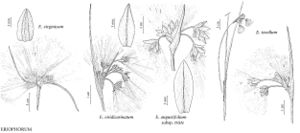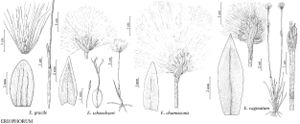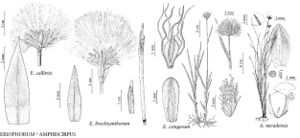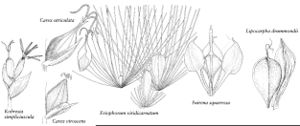Eriophorum
Sp. Pl. 1: 52. 1753.
Gen. Pl. ed. 5, 27. 1754.
Herbs, perennial, cespitose or not, rhizomatous. Culms solitary or not, trigonous or terete. Leaves basal and cauline; cauline leaves sometimes bladeless sheaths; ligules present; blades filiform to flat with filiform tip, to 25 cm × 2.5–4 mm. Inflorescences terminal, spikelets solitary, erect or (1–) 2–10 (–30) in subcapitate or subumbellate panicle; involucral-bracts 1–several, scalelike or blade-bearing and leaflike throughout. Spikelets: scales (10–) 20–200, spirally arranged, each subtending flower, or proximal empty. Flowers bisexual; perianth persistent, of (8–) 10–25 hairlike, smooth bristles, or very rarely 6 antrorsely barbed bristles, greatly elongate, essentially straight, usually obscuring most of scales in spikelet, much longer than achene; stamens 1–3; styles deciduous, linear, 3-fid. Achenes trigonous.
Distribution
Mostly in cool temperate, alpine, and arctic regions of the Northern Hemisphere
Discussion
Species ca. 25 (11 in the flora).
In some species the North American populations are considered to be conspecific with Eurasian populations; differences in achene micromorphology and isozyme data suggest that these relationships should be investigated more thoroughly.
Selected References
None.
Lower Taxa
Key
| 1 | Perianth bristles usually 6, 3–9 mm in fruit, usually antrorsely barbed; spikelets 3–10 mm in fruit. | Eriophorum crinigerum |
| 1 | Perianth bristles usually 10–25, 10+ mm in fruit, smooth; spikelets 10+ mm in fruit. | > 2 |
| 2 | Spikelets solitary, erect, without blade-bearing involucral bracts; distal leaves on culms bladeless or with blades not more than 1 cm; proximal scales of spikelets usually empty. | > 3 |
| 2 | Spikelets usually 2 or more, spreading or nodding, subumbellate or capitate, subtended by 1 or more blade-bearing involucral bracts, sometimes reduced to sheaths; distal leaves on culms with blades at least 1 cm; proximal scales of spikelets usually subtending flowers. | > 7 |
| 3 | Culms usually solitary; empty proximal scales usually not more than 7. | > 4 |
| 3 | Culms densely tufted; empty proximal scales usually 10 or more. | > 5 |
| 4 | Anthers not longer than 1.5 mm; perianth bristles bright white; spikelets broadly obovoid to subglobose in fruit; fertile scales with hyaline margins not more than 1 mm wide. | Eriophorum scheuchzeri |
| 4 | Anthers 1 mm or longer; perianth bristles red-brown to white; spikelets globose in fruit; fertile scales with hyaline margins at least 1 mm wide. | Eriophorum chamissonis |
| 5 | Proximal scales spreading or reflexed in fruit, with white-hyaline margins to 1 mm wide; perianth bristles pure white in fruit; distal sheaths on culms inflated. | Eriophorum vaginatum |
| 5 | Proximal scales appressed to ascending, without conspicuous whitish margins; perianth bristles white or brownish; distal sheaths on culms inflated or not. | > 6 |
| 6 | Culms to 70 cm, smooth; sheaths evenly distributed along culms, distal not inflated, bladeless; proximal scales with broad ribless margins; perianth bristles creamy white to pale brown; anthers to 2 mm. | Eriophorum brachyantherum |
| 6 | Culms not more than 25(–50) cm, rough distally; sheaths mostly confined to proximal 1/2 of culm, often with short blade; proximal scales with ribs ± to margins; perianth bristles white to pale brown; anthers to 1 mm. | Eriophorum callitrix |
| 7 | Inflorescences with single blade-bearing bract; leaf blades channeled in cross section for entire length, not more than 1.5(–3) mm wide. | > 8 |
| 7 | Inflorescences with (1–)2–5 blade-bearing bracts; leaf blades flat at least in proximal 1/2, 1.5–6+ mm wide. | > 10 |
| 8 | Anthers 2–5 mm; longer scales 5–10 mm, proximal scales without lateral ribs. | Eriophorum angustifolium |
| 8 | Anthers 1–2(–2.5) mm; longer scales 3–4.5 mm, proximal (2–)3–9-ribbed, lateral ribs usually thinner and shorter than central. | > 9 |
| 9 | Distal leaf blades 30–250 mm, longer than sheath; culms scabrous distally; scales with at least some red-brown. | Eriophorum tenellum |
| 9 | Distal leaf blades 10–40 mm, shorter than sheath; culms distally smooth; scales black or dark gray. | Eriophorum gracile |
| 10 | Scales brown often with green center, ribs obscure or several equally prominent; perianth bristles usually brown, at least proximally, rarely entirely white. | Eriophorum virginicum |
| 10 | Scales greenish gray to black with pale tip, midrib prominent; perianth bristles white or pale brown. | > 11 |
| 11 | Scales with midrib prominent and enlarged towards tip, sometimes excurrent; anthers 0.8–2 mm; peduncles scabrous. | Eriophorum viridicarinatum |
| 11 | Scales with midrib fading toward tip; anthers (2–)2.5–5 mm; peduncles smooth or scabrous. | Eriophorum angustifolium |
"shortened" is not a number.



